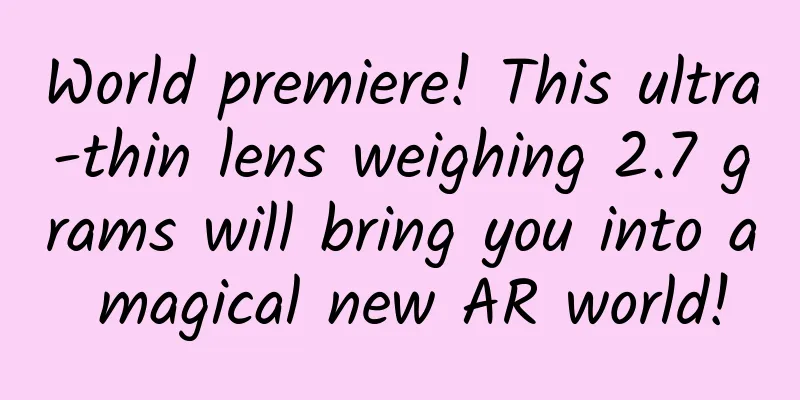World premiere! This ultra-thin lens weighing 2.7 grams will bring you into a magical new AR world!

|
With the rapid development of science and technology, AR technology is gradually becoming a new generation of productivity tools that change our lifestyle. AR is the abbreviation of Augmented Reality, and AR glasses allow the wearer to superimpose virtual scenes on the real world and realize virtual-real fusion and interaction through sensing and computing. Imagine that one day you can wear a pair of thin and cool glasses like Iron Man in science fiction movies, and instantly see all kinds of relevant information without any obstruction in your vision. At the Future Industry Research Center of Westlake University, these imaginations are gradually becoming a reality. On the morning of September 24, at the Science Cafe on the first floor of the Zhejiang Association for Science and Technology Building, Qiu Min, Guoqiang Chair Professor of Optical Engineering, Vice President of Westlake University, and Chief Scientist of Mud Micronano (Hangzhou) Technology Co., Ltd., demonstrated a pair of "magical" AR glasses to the public. This is the first public appearance of this pair of glasses, and it is also the global debut of the scientific and technological achievement of "extremely light and thin rainbow-free silicon carbide AR diffraction optical waveguide". The first team to try out silicon carbide lenses At the beginning of the event, the host asked everyone a question, "Do you know what silicon carbide is?" Only a few people nodded in response. Silicon carbide (SiC) is actually a semiconductor material. It is included in the most influential "100 scientific words" of 2023 released by the Science Popularization Department of the China Association for Science and Technology. Traditionally, it is used as an industrial raw material in the fields of refractory materials, metallurgical raw materials, etc. Now, Professor Qiu Min's team has proposed using silicon carbide to make lenses for AR glasses, which is a bold and new idea. Micro-nano optics is an emerging discipline that manipulates optical phenomena at a microscopic scale. It brings new technical solutions to optical devices and technologies, including AR lenses. Professor Qiu Min's team has been deeply engaged in the field of micro-nano optics for many years. In order to meet industry needs and promote the implementation of scientific research results, they established Mude Micro-Nano (Hangzhou) Technology Co., Ltd., focusing on the research and development of AR diffractive optical waveguides, diffractive optical elements, meta-optical devices and other products. The team has achieved a technological breakthrough from zero to one in the domestic high-end nanoimprint template, filling the gap in the domestic AR industry chain. Qiu Min and his team in the laboratory This time, the team broke the rules and combined the strength of micro-nano optical technology with perfect material properties to create this extremely light and thin silicon carbide AR glasses, and walked out of the laboratory and into the public eye. At the event, Du Kaikai, CEO of Moode Micronano (Hangzhou) Technology Co., Ltd., showed everyone this "magical" pair of glasses. At first glance, these glasses are no different from ordinary glasses. After wearing them, the host said, "I feel that they are even much thinner and lighter than the ordinary glasses I wear every day." Thinner, lighter and clearer, this pair of glasses turns science fiction into reality Professor Qiu Min further introduced the latest scientific research results from Westlake University. "Mobile phones have become our basic tool for interacting with the information world, but at the same time, they have tied our hands. How to solve this problem? The answer is wearable devices that can interact." Qiu Min described a vivid application scenario. "When you put on AR glasses, others may only see you sitting, but you are actually already watching a movie." "If you add interactive functions, when you look at the people around you, their names and information will appear near their heads, so you can say goodbye to face blindness. Wearing these glasses, you can recognize everyone and every flower and plant." Imagine a pair of AR glasses weighing only 5.4 grams and 0.55 mm thick, which is almost as light as the sunglasses you usually wear. Unlike traditional multi-layer high-refractive index glass lenses, thanks to the ultra-high refractive index of silicon carbide materials, this new technology only needs a single layer of waveguide to complete the full-color display task, which not only greatly reduces the weight of the lens, but the team also further compresses the volume through ultra-thin packaging technology, making it almost invisible to the wearer. After putting on this pair of AR glasses, you will find yourself in a whole new world, because they can superimpose clear and vast virtual images on the real environment, just like moving from a small window to a big door. A single-layer silicon carbide waveguide can theoretically support 80-degree full-color imaging, far exceeding the maximum full-color field of view of 40 degrees that traditional high-refractive index glass can provide. A larger field of view means better immersion and experience, whether it is a fantasy scene in a game or data visualization at work, it will bring an unprecedented visual feast. In addition, Qiu Min also introduced a solution to the rainbow pattern phenomenon that many people are worried about. The rainbow pattern is actually caused by the diffraction effect when the ambient light passes through the waveguide surface, forming a rainbow-like effect. Qiu Min's team completely eliminated this problem by precisely designing the waveguide structure, presenting a clean and clear picture to the user. At the same time, taking advantage of the good thermal conductivity of the silicon carbide material itself, this pair of glasses innovatively uses the lenses for heat dissipation, greatly improving the heat dissipation efficiency, making full-color and full-frame display no longer a luxury. At the same time, unlike the previous need for multiple waveguides to achieve full-color effects, this silicon carbide AR glasses only needs one waveguide to present rich and colorful content, and innovatively gets rid of the need for cover glass. This greatly simplifies the production process and allows more people to enjoy the convenience brought by this cutting-edge technology. As more and more innovative solutions like this emerge, we can foresee that in the near future, AR technology will truly be integrated into daily life, ushering in a new era full of infinite possibilities. Whether in education, medical care, entertainment or industry, AR glasses will become a bridge between the digital and real worlds. What else do you want to know about silicon carbide AR glasses? Q: What is the difference between the silicon carbide AR glasses released this time and Apple Vision Pro? Qiu Min: Vision Pro is a mixed reality (MR) product that combines VR and AR, and is relatively heavy. Because it relies on cameras to import external images, it may cause distortion or dizziness. In contrast, AR glasses are based on a transparent lens design, mainly displaying the real world, adding virtual elements only when necessary, reducing dizziness and pursuing a lighter and more comfortable wearing experience. Q: Can people with myopia wear AR glasses? Are silicon carbide lenses compatible with AR functions and myopia correction? Qiu Min: Myopia correction can be achieved in many ways, such as laminating the lens with a myopia lens or using new technologies such as Fresnel lenses. Our ultimate goal in the future is to customize solutions based on individual needs. Q: Is SiC (silicon carbide) material expensive? Can people afford glasses made of this material? Du Kaikai: Although the price of silicon carbide lenses is relatively high at present, for example, a four-inch lens used in our lenses costs one to two thousand yuan, and a six-inch lens costs three to four thousand yuan. However, as the technology matures and mass production begins, its price is expected to drop significantly in the future. Qiu Min: Let me give you an example. We often use LED lights now. The substrate used by LED bulbs is sapphire. Sapphire used to be very expensive, but now the price has dropped from several thousand yuan per piece to tens of yuan. If our silicon carbide AR glasses can be widely used, with an annual output of hundreds of thousands or millions of pieces, I believe its price will also drop from two or three thousand yuan to two or three hundred yuan, and may even drop to tens of yuan one day. |
Recommend
Civil Service Exam Sprint: 17 lessons to get high scores in essay writing, break through difficulties, and pass the exam easily
Course Description: 1. Comprehensive. The course ...
Bai Yansong: Nowadays, mobile phones push notifications based on hobbies, which is one of the most destructive ways to deal with people
According to the Beijing News, Bai Yansong, a mem...
Why can’t seawater extinguish submarine volcanoes?
In 1963, a volcano 130 meters below the sea surfa...
Here are all the ways to improve your APP’s monetization capabilities!
How can an app with hundreds of thousands, million...
Competing for popular "property projects" and abandoning "unfinished buildings", how did hermit crabs become "real estate transaction" tycoons?
The hermit crab is small in size, with an appeara...
"Nature" releases seven major scientific events worth paying attention to in 2022!
Although the COVID-19 pandemic is still raging th...
How to report crash logs when iOS App crashes continuously
To ensure the user experience of online apps, we ...
ASO trends in App promotion in 2019!
The promotion war between Baidu and Toutiao for t...
WeChat 8.0.2 is now available! New visitor permissions and 7 new changes
Recently, Apple iOS WeChat released version 8.0.2...
Detailed explanation of JSPatch implementation principle: Let JS call/replace any OC method
JSPatch is a small-sized JavaScript library that ...
How to carry out refined operations of financial products?
Now that the cost of acquiring customers is getti...
What are the differences between AMOLED and TFT-LCD screens?
First, let's talk about the light-emitting pri...
Why do companies rely on Baidu bidding hosting today?
Why businesses rely on Baidu hosting today With t...
Why do some landing pages make you want to buy after seeing them?
What’s changing in digital advertising ? What is ...
In the first seven months of 2023, global car sales reached 49.6 million units, and Chinese car companies produced 1/3 of them.
According to data released by the China Associati...









